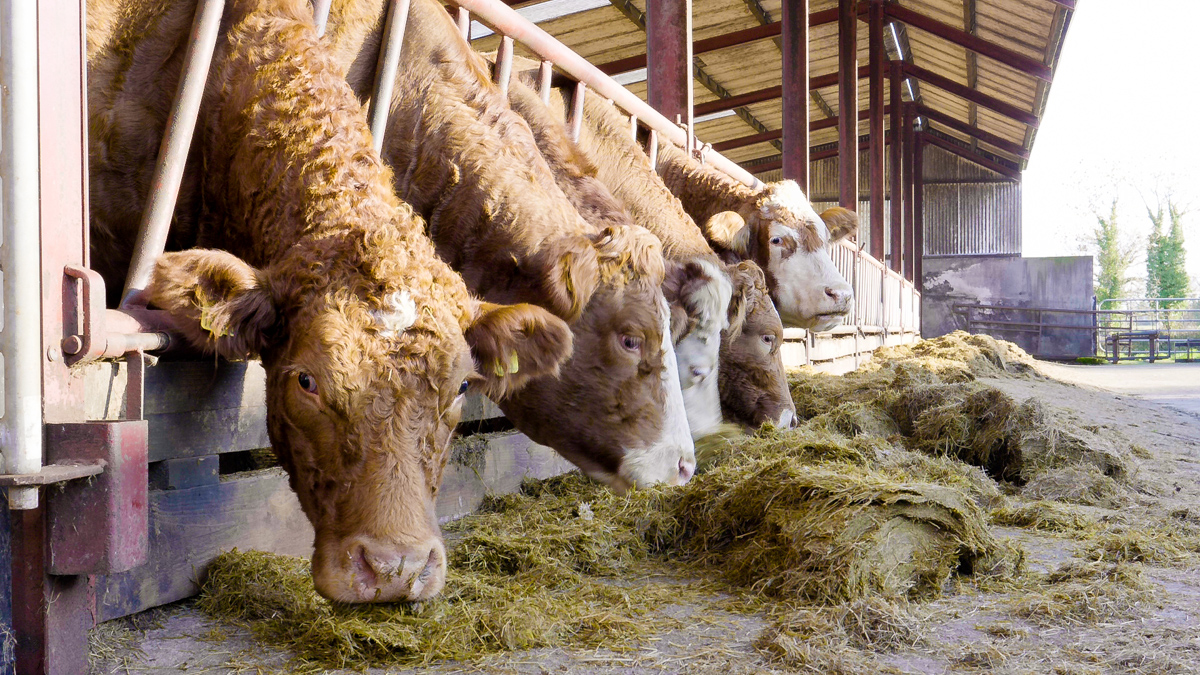Cattle rations usually have a base of cereals such as barley and maize. Some farmers have a preference for one cereal over the other, claiming cattle do a better thrive on one more so than the other.
This notion was put to the test in a trial conducted by Teagasc and University College Dublin (UCD) and the results were given at the recent BEEF2022 Open Day at Teagasc Grange in Co. Meath.
Involved in the trial were: Mark McGee, Rian Kennedy, Edward O’Riordan, Alan Kelly and Aidan Moloney.
In the trial, beef cattle were offered grass silage and supplemented with rolled barley or maize meal-based rations containing legumes, such as flaked beans and peas or maize by-products such as Corn Gluten Feed (CGF) and maize-dried distiller grains (MDD).
The cattle’s intake on this feed, growth and carcass traits were then determined.
Late-maturing suckler-bred steers were assigned to one of eight supplement treatments, formulated to have the same crude protein concentration (135g crude protein (CP)/kg dry matter (DM)).
The eight concentrate supplements were as follows:
- Rolled barley (622 g/kg fresh weight basis) plus flaked peas (300 g/kg);
- Rolled barley (722 g/kg) plus flaked beans (200 g/kg);
- Rolled barley (637 g/kg) plus CGF (285 g/kg);
- Rolled barley (780 g/kg) plus MDD (142 g/kg);
- Maize meal (507 g/kg) plus flaked peas(415 g/kg);
- Maize meal (622 g/kg) plus flaked beans (300 g/kg);
- Maize meal (522 g/kg) plus CGF (400 g/kg);
- Maize meal (702 g/kg) plus MDD (220 g/kg).
All concentrates contained molasses (50g/kg), and were balanced for minerals/vitamins.
To decrease the rumen degradable protein concentration, the peas and beans were flaked.
Steers were individually offered 4kg concentrate DM daily (in two feeds) in addition to grass silage (DM digestibility 779g/kg, 110 g CP/kg DM) ad lib for 110 days.
The results found that intake; growth; feed conversion efficiency (FCE); carcass weight; kill-out proportion; carcass conformation; and fat score and ultrasonic measures of body composition did not differ between the cereal ‘type’ fed (see Table 1 below).
Of note is that there were no differences in any measures of body fatness between the cereal types, which is consistent with results from previous experiments carried out at Teagasc Grange where maize meal partially replaced rolled barley in concentrate rations offered to bulls ad lib.
Under these experimental conditions, the feeding value of the rolled barley was equivalent to maize meal.
Table 1. Effect of cereal type (rolled barley and maize meal) and protein source (flaked beans, flaked peas, corn gluten feed (CGF) and maize dried distiller grains (MDD)) as supplements to grass silage on steer silage dry matter (DM) intake and performance: (NS = Not significantly different)

The research found that finishing cattle offered a maize meal-based concentrate compared to a rolled barley-based concentrate as a supplement to grass silage had similar intakes and cattle performed similarly on both.
Barley vs. oats
The effects of replacing rolled barley with rolled oats over a 134-day finishing period was also examined.
Animals were individually offered grass silage (DM digestibility 713 g/kg) ad
lib plus 4.0 kg DM (in two feeds) daily, of one of two concentrate supplements.
The two supplements were as follows:
- Barley-based ‘control’ (862g rolled barley, 60g soya bean meal, 50g molasses and 28 g minerals and vitamins/kg fresh weight);
- Oats-based (853g rolled oats, 70g soya bean meal, 50g molasses, and 27g minerals and vitamins/kg fresh weight).
Concentrates were prepared as coarse mixtures and were formulated to have the same CP concentration of 135 g/kg DM.
Intake, growth, feed conversion ratio (FCR), carcass weight, kill-out proportion, carcass confirmation and fat score and ultrasonic measures of body composition did not differ between the cereal ‘types’
Table 2: Effect of replacement of rolled barley with rolled oats on silage dry matter (DM) intake, average daily live weight gain, feed conversion ratio (FCR) and carcass traits of finishing steers offered grass silage.

In a subsequent experiment, intake, growth and carcass traits of late-maturing suckler steers offered 4.0kg DM daily (in two feeds) of either a rolled barley or oats-based concentrate ration with or without peas or beans as supplements to grass silage (DM digestibility, 725g/kg; CP, 152 g CP/kg DM) over 146 days, were examined.
Animals were assigned to one of six concentrate supplements:
- Rolled barley (922 g/kg fresh weight);
- Rolled barley (622 g/kg) plus flaked peas (260 g/kg);
- Rolled barley (742 g/kg) plus flaked beans (180g/kg);
- Rolled oats (922 g/kg);
- Rolled oats (642 g/kg) plus flaked peas (280 g/kg);
- Rolled oats (732 g/kg) plus flaked beans (190 g/kg).
All concentrates contained 50g/kg molasses and were balanced for minerals/vitamins.
Concentrates containing peas or beans were formulated to have the same CP concentration (144g CP/kg DM); the corresponding value for those not containing a protein ingredient was 116g CP/kg DM.
Consistent with the previous experiment, intake, growth, carcass weight, conformation and fat score, and ultrasonic measures of body composition did not differ significantly between steers offered barley and oats-based concentrate rations.
Overall, it was concluded that, under the conditions of these experiments, rolled oats can replace rolled barley in a concentrate supplement to high-digestibility grass silage without negatively affecting performance of beef cattle.
Legume grains – beans and peas as protein (and energy) sources
In two of the experiments outlined above, flaked beans and flaked peas were compared with each other, and in the first experiment they were also compared with corn gluten feed and maize dried distiller grains.
In the first experiment, the feeding value of beans or peas, corn gluten feed and maize dried distiller grains were equal (Table 1).
However, in the second experiment, the feeding value of beans was superior to peas.
Collectively, these results suggest that flaked faba beans can be readily used as an alternative feed ingredient when included in a concentrate ration offered as a supplement to grass silage for beef cattle. More research is required on the use of peas.
